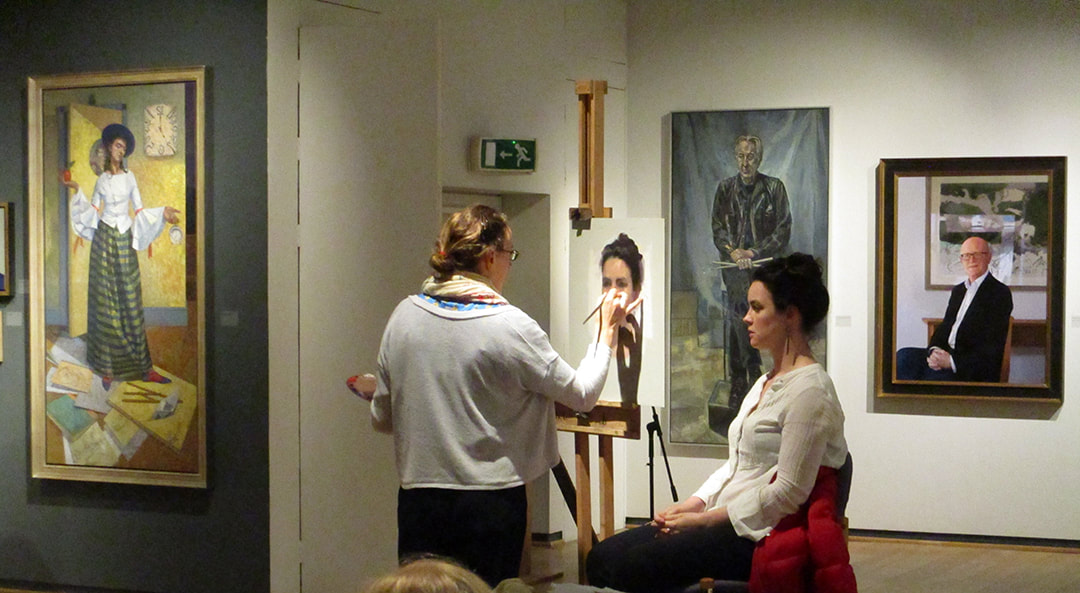"Annual Exhibition of the Royal Society of Portrait Painters" In these days when smart phones can and do take thousands, if not millions, of selfies and photos of other people, why do we need artists to produce pictures of people? The answer lies in the fact that reproducing a likness of someone is only a relatively unimportant part of producing a good portrait. To illustrate, the reason that the Mona Lisa is regarded as a great painting is not because people are impressed by how accurately DaVinci caught the likeness of La Gioconda, the wife of Francesco del Giocondo. Along the same lines, Van Gogh's portrait of Joseph Roulin, the postmaster in Arles, is not a great painting because it looks so much like the postmaster.
A good portrait conveys something about the human condition. In his or her interpretation of the sitter's features, the artist tells us something about that person. At the same time, the decisions made by the artist as to how to present the sitter, what to leave out and what to emphasize, tells us something about the artist. Just as a verbal statement about someone not only communicates something about that person, the statement also tells us something about the speaker. Portraiture has a long and great tradition in Great Britain. Indeed, eversince Hans Holbein documented the court of King Henry VIII, portraiture has been the leading art form in Britain. Over the centuries, the nation has produced portrait artists such as Thomas Gainsborough, Sir Joshua Reynolds, Sir Thomas Lawrence, Alan Ramsay, Henry Raeburn, Lucien Freud and David Hockney. Furthermore, the appreciation of portraiture in Britain attracted top portrait artists from other countries to come to Britain including Anthony Van Dyck, Sir Peter Lely, John Singer Sargent, and James McNeil Whistler. Indeed, Holbein was from continental Europe. As the Annual Exhibition of the Royal Society of Portrait Painters demonstrates, portraiture is alive and well in Britain. The Society of Portrait Painters, as it was then named, was formed in 1891 when a group of artists became dissatified with the policies of the Royal Academy of Art. Early members included John Everett Millais and Augustus John as well as Sargent and Whistler. In 1911, King George V conferred the status of a royal society on it and so the name was changed to the Royal Society of Portrait Painters. The royal connection continues as Queen Elizabeth II is the patron of the Society. The Annual Exhibition, held at the Mall Galleries, is open to members of the Society and to non-members. A selection committee made up of portrait artist members decides which submissions will be exhibited. The exhibition includes more than 200 works. Works in all media except sculpture and photography are eligible. However, the vast majority of the works in this year's exhibition were oil paintings. There were a few pastels but we did not see any acrylics or watercolors. One section of the exhibition was devoted to portrait drawings, which is not surprising since the Prince of Wales award is for portrait drawing. Most works could be termed traditional realism. However, there were also looser works showing the influence of Impressionist and Port-Impressionist painting. The artists successfully avoided the ugliness fad that has plagued portrait art in recent years. The notion that a portrait has to be ugly to be meaningful has no more validity than its polar opposite, i.e. the notion that a painting has to be pretty to be good. While we enjoyed the diversity of styles and subjects in this exhibition, what was most impressive was the artists' ability to communicate something about the human condition to the viewer. This was true both of the formal commissioned works as well as the works depicting unidentified individuals. |
Above: Frances Bell RP giving a demonstration during the Royal Society of Portrait Painters Annual Exhibition.
|
Art review - Mall Galleries - “Annual Exhibition of the Royal Society of Portrait Painters”

